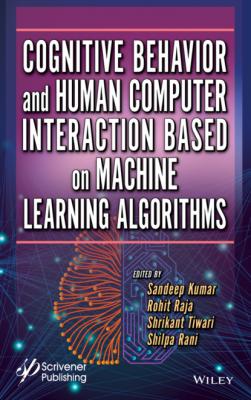Cognitive Behavior and Human Computer Interaction Based on Machine Learning Algorithms. Группа авторов
Чтение книги онлайн.
Читать онлайн книгу Cognitive Behavior and Human Computer Interaction Based on Machine Learning Algorithms - Группа авторов страница 15

Enactive.
So, various interactive devices like Individual Intelligences Interactions (I3), Artificial and Individual Intelligences Interaction (AI3), Brain-Computer Interaction (BCI), and Individual Interactions through Computers (I2C) in a playful manner are provided to meet the corporate challenges in all stakeholders of various domains with better user experience.
1.6 Conclusion and Scope
Cognitive modeling plays a significant and strategic role in human-computer interaction devices deployed these days and in the future, with artificial intelligence, deep learning, and machine learning computing techniques. Data science and data analytics provided an accurate visualization analysis with customer feedback experiences to know the expeditions of the users with their interactions of the above interactive devices. User experience is the crucial factor of any successful interacting device between machine and human because decisions can be uncertain due to various situations. One of the key strengths of the cognitive model interactive device system is its many practical applications. It is used in the field experiment to investigate the effects of cognitive interviewing techniques training on detectives’ performance in eyewitness interviews. This means that studies taking the cognitive approach are somewhat scientific and have good internal validity in the long future deterministic decision-making in all the levels of management decisions.
References
1 Ritter, F.E., Baxter, G.D., Gary, R.M., Supporting Cognitive Models as Users. ACM Trans. Comput.-Hum. Interact., 7, 2, 141–173, June 2000.
2 Boden, M.A., Artificial Intelligence, A Volume in Handbook of Perception and Cognition, School of Cognitive and Computing Science University of Sussex Brighton, England, Elsevier Inc. Book, 1996.
3 Bernd, Liepert, T., Hahn, A.B., Vasilyeva, A., An AI PPP A focal point for collaboration on Artificial Intelligence, Data and Robotics, Second Consultation Release, September 2019.
4 Sanders, N., A Balanced Perspective on Prediction and Inference for Data Science in Industry. Harv. Data Sci. Rev., 1.1, 1–29, Summer 2019, Sep 18, 2019.
5 Rasta, P., A Planning Guide - Mariana Patra, Information and Communication Technologies in Teacher Education, The University of Texas at Austin (USA), Division of Higher Education UNESCO 7, place de Fontenay 75352 Paris 07 SP, France, 1998.
6 Pew, R.W. and Mayor, A.S., Committee on Human-System Design Support for Changing Technology, National Research Council of the National Academies, The National Academies Press, Washington, D.C., April 1991.
7 Shawn, T., Järvenpää, S., Lee, A.S. (Eds.), Process Models in Information Systems, in: Information Systems and Qualitative Research, © Springer Science Business Media Dordrecht, University of Texas at Austin, USA, 1997.
8 Alvarez-Cores, V., Zarate, V., Ramirez Uresis, J.A., Zayas, B.E., Current Challenges and Applications for Adaptive User Interfaces, in: Human–Computer Interaction, I. Maurtua (Ed.), pp. 13–30, IntechOpen, Rijeka, Croatia, 2009.
9 Karim, A.J., the significance of management information systems for enhancing strategic and tactical planning. J. Inf. Syst. Technol. Manage. (Online), 8, 2, 459–470, São Paulo 2011.
10 Zhang, P. and Galleta, D., Human–Computer Interaction and Management Information Systems: Foundations, 2006.
11 Samson, A., an introduction to Behavioral Economics, Guide Behavioral Economics Guide, Behavioral Science Solutions Ltd and the London School of Economics, 2014.
12 Grosz, A.E., Lai, A.J.F., Schultz, D. et al., Methods and systems for background uploading of media files for improved user experience in production of media-based products, US Patent US 8,799,829 B2, assigned to Interactive Memories, Inc., 2014.
13 Filippos, L. and Mastriano, O., Managerial Decision Support Making in Economic Systems Based on Cognitive Modeling. Int. J. Eng. Technol., 7, 4.3, 588–592, 2018.
14 Berna, I., Stefan, K., Pawed, M. et al., Building Information Modelling, Construction Managers’ Library, Erasmus, Iceland, Great Britain, 2015.
15 Chen, A., Starke, S.D., Baber, C. et al., A Cognitive Model of How People Make Decisions Through Interaction with Visual Displays School of Psychology. ACM proceedings of the HCI Conference on human factors in computing systems, May 2017, pp. 1205–1216.
16 Ritter, F.E., Baxter, G.D. et al., User interface evaluation: How cognitive models can help, in: Human-computer interaction in the new millennium, J. Carroll (Ed.), pp. 125–147, Addison-Wesley, Reading, MA, 2001.
17 Paschal, M.F. and Stary, C., The Role of Cognitive Modeling for User Interface Design Representations: An Epistemological Analysis of Knowledge Engineering in the Context of Human-Computer Interaction. Mind. Mach., 8, 203–236, 1998.
18 Houdashelt L, G., Marietta, C.D., Watson, H.J. et al., The Management Information and Decision Support (MIDS) System at Lockheed- Georgia, Executive Information System. MIS Quart., 5, 1–18, March 1998.
19 Ward, D. and Stapleton, M., Es are good Cognition as enacted, embodied, embedded, affective and extended, School of Philosophy, Psychology and Language Sciences, University of Edinburgh, Edinburgh, Scotland, United Kingdom, May 2016.
20 Peerce, J., Rogers, Y., Sharp, H., Interaction design: beyond human- computer interaction, John Wiley & Sons, Inc, Southern Gate, Chichester, West Sussex, UK, 2002.
21 Bernard, C., Paris-Dauphine et al., Group Model Building Using System Dynamics: An Analysis of Methodological Frameworks, Control Systems, Robotics, And Automation, in: Human-Machine Interaction, vol. xxi.
22 Grayed, J.D., Dual Process Theories in Behavioral Economics and Neuro economics: A Critical Review. Rev. Philos. Psychol., 11, 105–136, 2020.
Конец ознакомительного фрагмента.
Текст предоставлен ООО «ЛитРес».
Прочитайте эту книгу целиком, купив полную легальную версию на ЛитРес.
Безопасно оплатить книгу можно банковской картой Visa, MasterCard, Maestro, со счета мобильного телефона, с платежного терминала, в салоне МТС или Связной, через PayPal, WebMoney, Яндекс.Деньги, QIWI Кошелек, бонусными картами или другим удобным Вам способом.